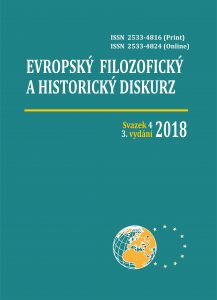Nadiia Lyubovets, PhD in History
Institute of Biographical Research, V. I. Vernadskyi National Library of Ukraine, Kyiv, Ukraine
How to cite: Lyubovets, N. (2023). Travel Notes of Luka Yatsenko-Zelenskyi in the Context of the Development of the Ukrainian Memoir Tradition of the ХVІІІ Century [Podorozhni zapysky Luky Yatsenka-Zelenskoho u konteksti rozvytku ukrainskoi memuarnoi tradytsii XVIII stolittia]. European Philosophical and Historical Discourse, 9, 3, 5-10. https://doi.org/10.46340/ephd.2023.9.3.1
Abstract
The travel notes of Luka Yatsenko-Zelenskyi are considered in the context of the development of the Ukrainian memoir tradition, the complex and long path of genre development, the circle of authors, and thematic focus. The first sample of travelers in the Ukrainian memoir tradition appeared in the 12th century. The genre of travelers has gone from classic descriptions with a pronounced Christian component to journeys that contained, in addition to religious, secular motives with the inclusion of plots with biographical and historical information. The most vivid changes in the genre of pilgrimage prose can be traced in “Journeys to the Holy Places of the East from 1723 to 1747” by Vasily Hryhorevich-Barsky, which had a pronounced educational and secular character. The handwritten work of Luka Yatsenko-Zelensky “The Younger Grigoryevich” belongs to travels with secular motives. It has been established that the manuscript of the travel notes is most likely in the archives of Moscow and St. Petersburg. In Ukraine, they were published for the first time by Dmytro Yavornytskyi under the title “Two Trips to Zaporizhia Sech Yatsenko-Zelensky, a Monk of the Poltava Monastery in 1750-1751.” in Ekaterinoslav in 1915. Luka Yatsenko’s travels included classic descriptions of the Christian shrines of the East – descriptions of different aspects of the life of Eastern Orthodox monasteries, customs and the life of monks are presented. However, they were saturated with biographical information, including descriptions of the author’s stay in the Poltava Holy Cross Monastery, correspondence with the Poltava hieromonk Martinian, life in Istanbul. At the same time, full of historical information, in particular, about Ukrainian and Russian church and secular dignitaries, about the trip to Zaporizhia Sech in 1749, 1750 and 1751. – representatives of Cossack officers, ordinary Sechevichs, Haydamaks, merchants, burghers and peasants. Luka Yatsenko-Zelensky’s notes are a sample of baroque works with their inherent humor, which was called “Cossack” in literary studies.
Keywords: ukrainian memoir tradition, travel notes, Luka Yatsenko-Zelenskyi, Archimandrite Leontius, memoirs.
References
- Bilokon, S. (1988). Yatsenko L. Molodshyi Hryhorovych: uryvok [pro poizdku na Sich] [The Younger Hryhorovych: excerpt [about the trip to Sich]. Vitchyzna, 2, 184–191. [In Ukrainian]
- Bilous, P. (1997). Palomnytskyi zhanr v istorii ukrainskoi literatury [Pilgrimage genre in the history of Ukrainian literature]. Zhytomyr. [In Ukrainian].
- Halych, O. A. (2008). U vymirakh non-fiction: Shchodennyky ukrainskykh pysmennykiv XX stolittia
[In non-fiction dimensions: Diaries of Ukrainian writers of the 20th century]. Luhansk : Znannia. [In Ukrainian]. - Holobutskyi, P.V. (2005). Zelenskyi–Iatsenko Leontii [Zelenskyi-Yatsenko Leontiy]. Entsyklopediia istorii Ukrainy, 3, 324-325. [In Ukrainian].
- Kuzyk, T. (2005). Koly Luka Yatsenko-Zelenskyi buvav u Zaporizkii Sichi? [When did Luka Yatsenko-Zelensky visit Zaporozhye Sich?]. Naukovi zapysky. Zbirnyk prats molodykh vchenykh ta aspirantiv, 10, 216-224.
[In Ukrainian]. - Mylchev, V. I. (2011). Kozatski naratyvy XVIII stolittia yak dzherelo vyvchennia sotsialnoi istorii Zaporizhzhia [Cossack narratives of the 18th century as a source for studying the social history of Zaporozhye]. Naukovi pratsi istorychnoho fakultetu Zaporizkoho natsionalnoho universytetu, XXX, 244-251. [In Ukrainian].
- Popov, A. P. (1914). «Mladshyi Hryhorovych», novootkrыtыi pamiatnyk po sviatыm mestam 18 v. [“Hryhorovych Jr.”, a newly opened monument to holy places of the 18th century]. Trudы 15-ho arkheolohycheskoho sъezda. Moskva, 1, 88 – 89. [in Russian].
- Popov, A.P. (1911). Mladshyi Hryhorovych. Novootkrыtыi palomnyk po sv. mestam XVIII veka.
[Hryhorovych Jr.: A Newly Discovered Pilgrim to Holy Places of the 18th Century.]. Kronshtadt. [in Russian]. - Franko, I. (1983). Zibrannia tvoriv u p’iatdesiaty tomakh. T. 28. Literaturno-krytychni pratsi (1890-1892)
[The collection is composed in fifty volumes. Vol. 28. Literary and critical works (1890-1892).].
Kyiv: Naukova dumka. [In Ukrainian]. - Chyzhevskyi, D. (1956). Istoriia ukrainskoi literatury = History of Ukrainian Literature : vid pochatkiv do doby realizmu [History of Ukrainian Literature: from the beginning to the age of realism]. Niu-Iork: UVAN u SShA.
[In Ukrainian]. - Evarnitckii D. I. (1915). Dve poezdki v Zaporozhskuiu Sech Iatcenka-Zelenskogo, monakha Poltavskogo monastyria, v 1750-1751 gg. [Two trips to Zaporizhia Sech by Yatsenko-Zelensky, a monk of the Poltava Monastery, in 1750-1751]. Ekaterinoslav : Tip. K.A. Andrushchenk. [in Russian].
